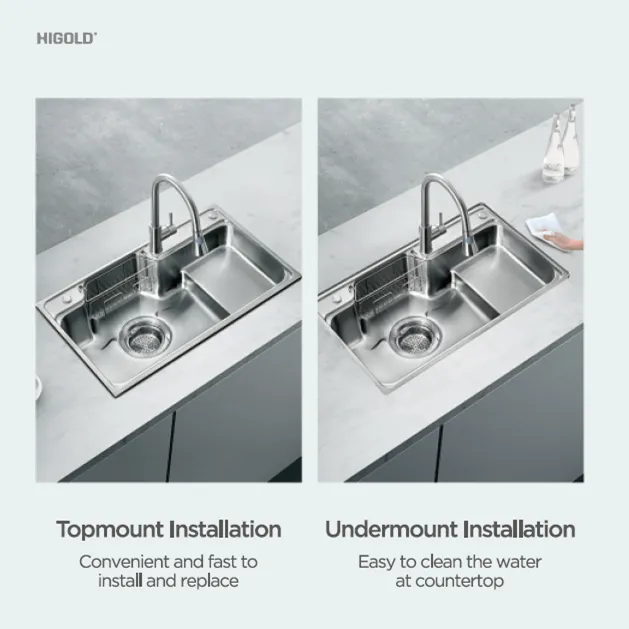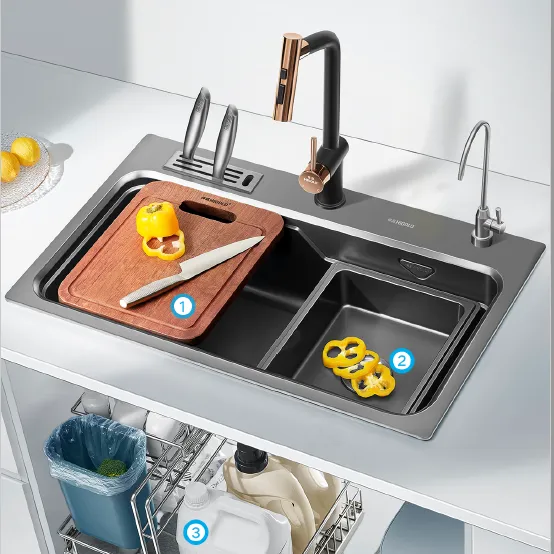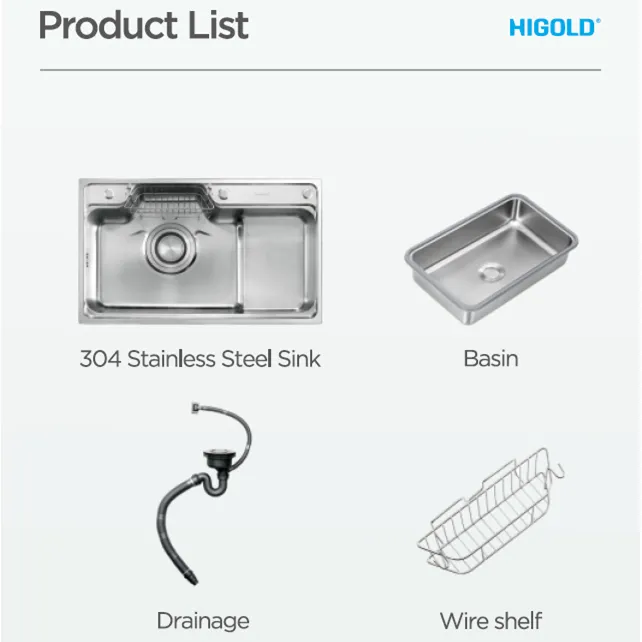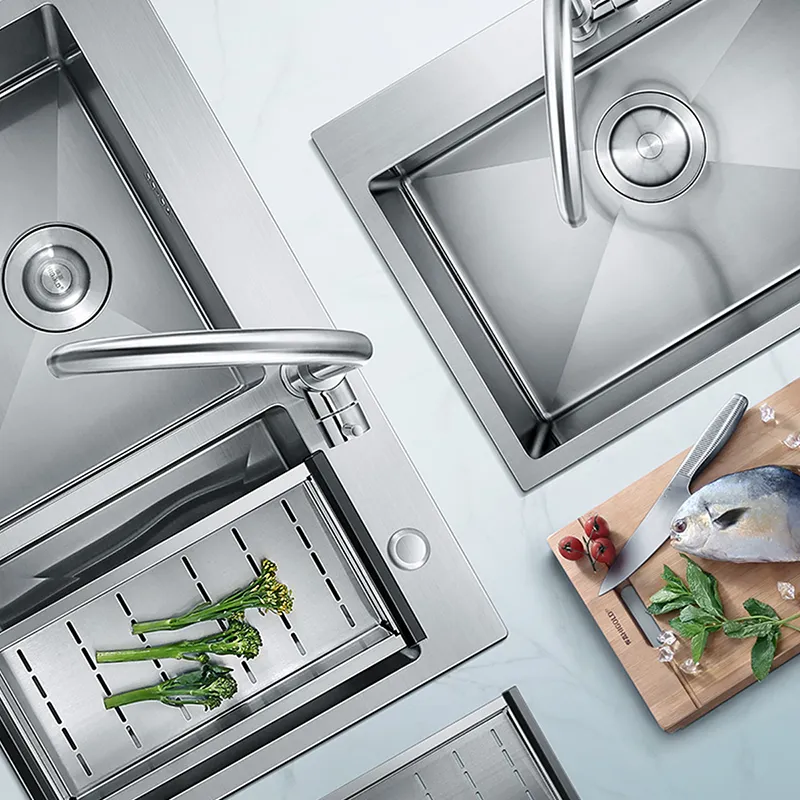A kitchen stainless steel sink's function extends beyond washing vegetables and dishes; it's a crucial component of kitchen operations. As a result, sink design details, particularly the metal rack at the bottom, have become a crucial component of a kitchen stainless steel sink's design. While the metal rack may appear inconspicuous, its presence significantly enhances the sink's practicality, durability, and ease of cleaning.
This article will delve into the various uses of the metal rack at the bottom of a kitchen stainless steel sink and its importance in the kitchen, helping consumers better understand this design detail and make more informed decisions when choosing and using a kitchen stainless steel sink.

What is the metal rack at the bottom of a kitchen stainless steel sink?
Most kitchen stainless steel sinks feature a metal rack or similar support structure at the bottom. These racks are typically made of stainless steel, aluminum alloy, or other durable metal materials, offering excellent corrosion resistance and durability. The rack is typically installed parallel to the sink's base, forming a grid or grating structure designed to serve various functions.
What is the function of the metal rack at the bottom of a stainless steel sink?
The purpose of a stainless steel kitchen sink rack:
1. Prevents scratches and wear on the sink bottom
2. Facilitates drainage and ventilation
3. Increases sink storage space
4. Prevents stains from accumulating
5. Reduces noise levels
6. Enhances aesthetics and overall design

1. Prevents Scratches and Wear on the Sink Bottom
One of the most basic functions of a kitchen sink rack is to protect the sink bottom from the scratches and wear of daily use. Stainless steel kitchen sinks often come into contact with knives, pots, and other hard objects, which can cause scratches or damage. The metal rack isolates these objects from the sink bottom, reducing direct impact and friction on the sink surface, thereby effectively extending the sink's lifespan.
This design is particularly important for stainless steel sinks. Although stainless steel sinks are highly durable, they can still be scratched by long-term impact from hard objects. Adding a metal rack to the sink bottom not only prevents this problem but also maintains the sink's smooth and beautiful surface.
2. Aids Drainage and Ventilation
A metal rack under a kitchen sink typically features a grid or grating. This design prevents food debris and water from directly contacting the sink floor. The rack improves drainage, preventing water from accumulating inside the sink, and reducing the risk of bacterial growth.
In addition, the rack promotes air circulation under the sink, which is crucial for preventing moisture accumulation and keeping the sink dry. Water often accumulates under the sink when washing vegetables, food, or dishes. Without a rack, moisture can accumulate, leading to stains and mold growth. A metal rack, however, allows for ventilation under the sink, allowing water to drain away quickly, reducing scale buildup and other sanitation issues.
3. Increased Sink Storage Space
A metal rack also increases storage space within the kitchen sink. Many racks feature compartments to separate food debris, dishes, or washing utensils from the sink floor. This design makes it easier for consumers to clean dishes and ingredients while also preventing unnecessary clutter from accumulating inside the sink.
During daily cooking, many people soak or rinse dishes directly in the sink. Placing these dishes directly on the sink floor can hinder draining and cleaning. A metal rack allows dishes and ingredients to be placed on the rack, preventing them from coming into direct contact with the sink floor, thereby improving sink cleanliness and efficiency.
4. Prevents Stain Accumulation
A metal rack at the bottom of the sink also helps prevent stains from accumulating. While using the sink, water removes food debris and water, but these stains can accumulate on the bottom, especially in sinks with indentations or curves. The metal rack's grating design creates a flat surface on the sink floor, effectively preventing stains from accumulating.
Especially when cleaning dishes, grease and water stains can easily accumulate on the sink floor. Over time, these stains can form stubborn stains, affecting the appearance and hygiene of the sink. The metal rack's structure allows water and stains from dishes to drain quickly, preventing the sink bottom from becoming dirty, significantly reducing the burden of cleaning.
5. Reduce Noise
Many consumers may not realize that metal racks can also help reduce noise during sink operation. When dishes or food residue fall into a sink, it often creates noise, which can be unpleasant in some environments. A metal rack cushions this impact, reducing the clatter caused by direct contact between dishes and the sink. Especially in deep sinks, the metal rack effectively absorbs shock, making the sink quieter.
6. Enhance Aesthetics and Overall Design
The metal rack at the bottom of a stainless steel kitchen sink not only serves a practical function but also enhances the sink's aesthetics and overall design. Modern kitchens are increasingly emphasizing the design of kitchen accessories. As an integral part of the sink, metal racks often complement the style of the sink itself, creating a simple and refined effect. Whether in a traditional or modern minimalist kitchen, metal racks blend seamlessly into the overall kitchen environment, enhancing the sink's overall visual appeal.
Furthermore, metal racks are often polished or otherwise treated to create a lustrous finish, adding a modern touch and enhancing the sink's visual appeal. For consumers who prioritize style in their kitchens, a metal rack under the sink is a key design element.

How to Choose a Kitchen Sink with a Metal Rack?
When choosing a kitchen sink with a metal rack, consumers should consider the following aspects:
1. Material Selection
The material of the metal rack typically matches the material of the sink. Stainless steel sinks typically use stainless steel for their improved corrosion and stain resistance. Sinks made of other materials may use aluminum alloy or other metals. Consumers can choose a metal rack based on the material of the sink, the overall kitchen decor, and their personal preferences.
2. Rack Design
Metal racks come in many different designs, including grids, lattices, and three-dimensional compartments. Consumers should choose a design that suits their sink's size, usage requirements, and aesthetics. Grid designs are suitable for most homes, while grate designs are more suitable for environments requiring efficient drainage and ventilation.
3. Ease of Cleaning
While metal racks offer many advantages, consumers should also consider cleaning difficulty when choosing one. Metal racks should be designed to facilitate cleaning, preventing food residue and stains. Choosing a well-designed, smooth-surfaced metal rack will make cleaning even easier.

Does Higold supply handmade sinks as well as pressed sinks?
Yes, Higold manufactures both handmade and pressed kitchen sinks. Handmade sinks are produced using robotic welding and edge grinding technology, ensuring superior finish and strength. These models are ideal for high-end markets or custom kitchen projects. Pressed sinks, on the other hand, are mass-produced using automated stamping machines for budget-friendly applications. Buyers can choose from both ranges depending on price targets and customer preferences.


